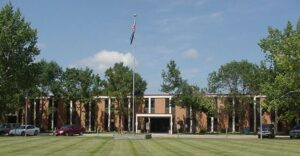 The North Dakota School for the Deaf has a fully accredited school serving students who are deaf or hard of hearing preschool through 8th grade. It also serves 0-3 year old through its Parent Infant Program (PIP), school age students in public schools through its outreach program and has a strong adult outreach. It serves approximately 20 students on campus, 40 children in the PIP program, 170 students in other school settings and over 500 adults. North Dakota is a rural state and NDSD serves as a Resource Center for deaf and hard of hearing across the state.
The North Dakota School for the Deaf has a fully accredited school serving students who are deaf or hard of hearing preschool through 8th grade. It also serves 0-3 year old through its Parent Infant Program (PIP), school age students in public schools through its outreach program and has a strong adult outreach. It serves approximately 20 students on campus, 40 children in the PIP program, 170 students in other school settings and over 500 adults. North Dakota is a rural state and NDSD serves as a Resource Center for deaf and hard of hearing across the state.
Prior to March 2020
The school was providing services in a variety of methods. The students at the model school were showing growth and progress in their academics and social skills development. The PIP was working with families in their home to help develop children’s language and auditory skills. The outreach was going to the public schools and providing assistance with programming and assessments while adult outreach was meeting clients in their homes and facilitating support groups in Sr. Centers across the state. The school was also providing in person trainings and workshops for state agencies, community groups and schools.unication took place through the ISD website and social media accounts.
During March-June 2020
The students had returned to the dorm when the governor announced the closing of all schools. Parents were contacted and transportation was provided to return students to their families. The home districts of the students were contacted and they provided two meals a day for the students throughout the rest of the school year. Laptops or IPads were mailed or delivered to all the students and staff since they all began working from home. Individual plans were developed with the parent/guardians for each student and individual virtual lessons began.
Paper packets including books were also sent home weekly. Students that did not have internet access were provided this for no cost by their local cable or telephone companies. Newsletters were mailed and posted on Facebook to keep the community informed while parents were contacted at least weekly. The teachers, parents and students were all learning a new way to share information and have ongoing communication. The PIP program continued to serve the children virtually working closely with the parents. The adult outreach sent weekly fliers with the topics that would have been covered in the support groups and educational videos were produced and shared a number of ways.
How the School Rose to the Challenge
The challenge of teaching at a distance was a new concept for the school. The staff, parents/guardians and students were required to learn new technology almost overnight. The education team of teachers, health services, and dorm counselors met regularly to develop individual lessons for each student to teach computer skills along with the academic lessons. They found the students were feeling isolated and missing their peers and the social interactions.
The lessons on zoom were opened up for others to join and this became a great time to be teaching social skills, language and auditory development, along with the academic lessons. The lessons became more interactive and the groups continued to grow. At one time teachers, the nurse, dorm counselors and all the classmates could be participating in a lesson. The students continued to gain skills and feel connected to the school. Parent/guardians developed a better understanding of the school programs and shared that the students looked forward to their time with their teachers and friends and did not want the sessions to end.
Where the School is Now
The school year ended May 21, with students receiving personal visits from staff with their awards, summer projects, and supplies left at the dorm. The videos of these meetings is heartwarming. The PIP program continues to provide virtual visits with their families and is accepting new identified children into the program. The adult outreach has begun some essential home visits and continues to mail flyers to the members of the support groups since the Sr. Centers are still closed. The planning process is in place to reopen in the fall.
Looking Ahead
Distance learning is a method of teaching deaf and hard of hearing students although teaching in person has many advantages. The students need to have greater computer and technology skills to be prepared for future. We are a rural state with intense winters, could we switch to distance learning rather than take storm days? Could we allow students to join classes virtually from home if they are recovering from an illness? The ideal situation is to have students on campus with hands on direct instruction but when this is not available it is still important to keep the students and teachers connected.
Superintendent: Dr. Connie Hovendick

